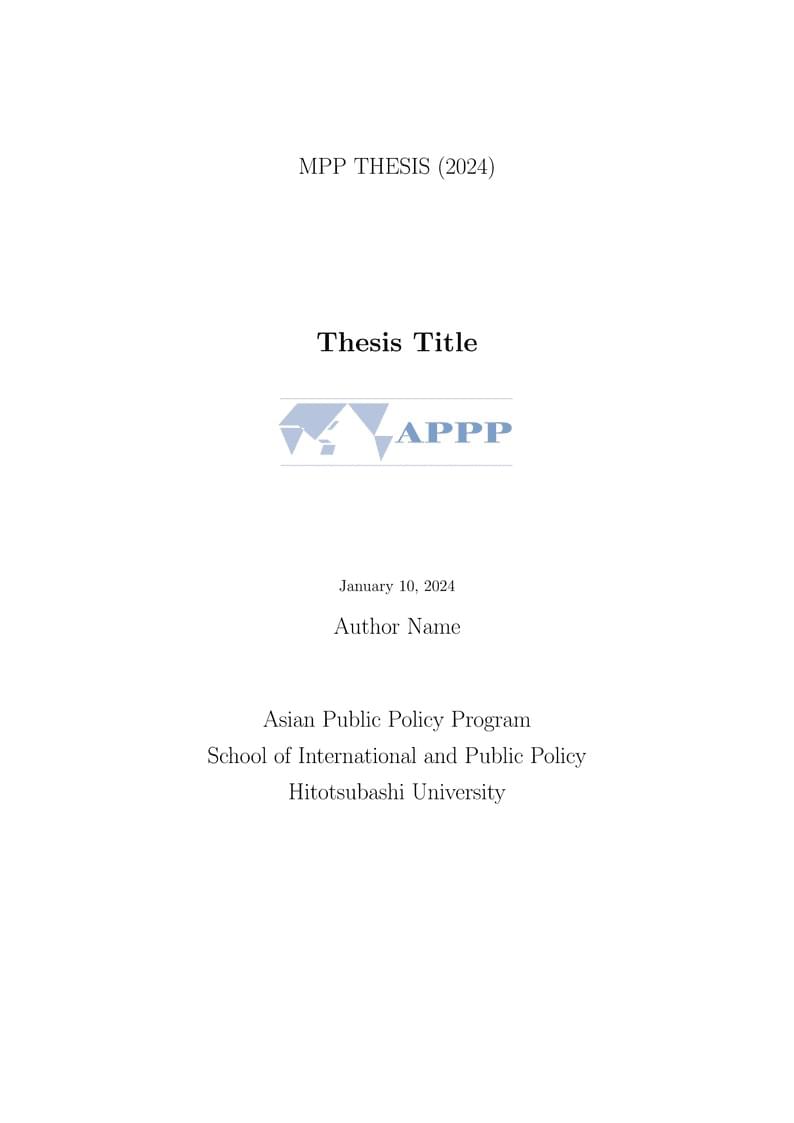
APPP (Hitotsubashi University) Thesis Template
Forfatter:
Hoang Tran
Sidst opdateret:
2 år siden
Licens:
Creative Commons CC BY 4.0
Resumé:
©APPP 2024.

\begin
Discover why over 20 million people worldwide trust Overleaf with their work.

\begin
Discover why over 20 million people worldwide trust Overleaf with their work.
\documentclass[a4paper, 12pt]{report}
%% Declare the packages used in the template
\usepackage{amssymb,amsmath,amsfonts,eurosym,geometry,ulem,graphicx,caption,color,setspace,sectsty,comment,footmisc,caption,pdflscape,subfigure,array,authblk,lipsum,float,graphicx,blindtext}
\graphicspath{{attachment/}} % Path to the folder containing the image files
\usepackage[hidelinks]{hyperref} % Make cross-references and hyperlinks clickable without boders around
\usepackage{subfiles} % Best loaded last in the preamble
\usepackage{natbib} % For creating bibliography.
\usepackage{pythonhighlight} %For typing Python code
\usepackage[Sonny]{fncychap} %For Chapter style
\ChNameUpperCase
\ChTitleVar{\Large\sc}
\usepackage{listings} %For adding other language code
\usepackage{upquote}
\usepackage{xcolor}
%%%% Set up styles and colour for programming code
\definecolor{codegreen}{rgb}{0,0.6,0}
\definecolor{codegray}{rgb}{0.5,0.5,0.5}
\definecolor{codepurple}{rgb}{0.58,0,0.82}
\definecolor{backcolour}{rgb}{0.95,0.95,0.92}
\lstdefinestyle{mystyle}{
backgroundcolor=\color{backcolour},
commentstyle=\color{codegreen},
keywordstyle=\color{magenta},
numberstyle=\tiny\color{codegray},
stringstyle=\color{codepurple},
basicstyle=\ttfamily\footnotesize,
breakatwhitespace=false,
breaklines=true,
captionpos=b,
keepspaces=true,
numbers=left,
numbersep=5pt,
showspaces=false,
showstringspaces=false,
showtabs=false,
tabsize=2
}
\lstset{style=mystyle}
\normalem
\onehalfspacing
\newtheorem{theorem}{Theorem}
\newtheorem{corollary}[theorem]{Corollary}
\newtheorem{lemma}[theorem]{Lemma}
\newtheorem{proposition}{Proposition}
\newenvironment{proof}[1][Proof]{\noindent\textbf{#1.} }{\ \rule{0.5em}{0.5em}}
\newtheorem{hyp}{Hypothesis}
\newtheorem{subhyp}{Hypothesis}
\newcommand{\red}[1]{{\color{red} #1}}
\newcommand{\blue}[1]{{\color{blue} #1}}
\newcolumntype{L}[1]{>{\raggedright\let\newline\\arraybackslash\hspace{0pt}}m{#1}}
\newcolumntype{C}[1]{>{\centering\let\newline\\arraybackslash\hspace{0pt}}m{#1}}
\newcolumntype{R}[1]{>{\raggedleft\let\newline\\arraybackslash\hspace{0pt}}m{#1}}
\geometry{left=1.0in,right=1.0in,top=1.0in,bottom=1.0in}
%%%%%%%%%%%%%%%%%%%%%%%%%%%%%%%%%%%%%%%%%%%%%%%%%%%%%%%%%%%%%%%%%
\begin{document}
%%%% COVER PAGE (include Abstract) %%%%%
\begin{titlepage}
\begin{center}
\vspace*{1cm}
\text{\Large MPP THESIS (\the\year{})}
\vspace{4cm}
\textbf{\LARGE Thesis Title}
\vspace{1 cm}
\includegraphics[width=0.4\textwidth]{appp_sym.png}
\vspace{2.5cm}
\today
\vspace{.5cm}
\text{\Large Author Name}
\vspace{1.5cm}
\Large
Asian Public Policy Program\\
School of International and Public Policy\\
Hitotsubashi University
\setcounter{page}{0}
\thispagestyle{empty}
\end{center}
\end{titlepage}
\pagebreak \newpage
%%%%%%%%%%%%%%%%%%%%%%%%%%%%%%%%%%%%%%%%%%%%%%%%%%%%%%%%%
\clearpage %Empty page
%%%%%%%%%%%%%%%% GENERAL INFORMATION %%%%%%%%%%%%%%%%%%%%%%%%%
% You can modify sections and subsection to fit with your work.
%%%% ABSTRACT %%%%
\doublespacing
\chapter*{Abstract} \label{sec:abstract}
\pagenumbering{roman}
\lipsum[1-2]
%%%%%%%%%%%%%%%%%%%%%%%%%
\pagebreak \newpage
%%%% ACKNOWLEDGMENTS %%%%
\doublespacing
\chapter*{Acknowledgements} \label{sec:acknowledgment}
%%%%%%%%%%%%%%%%%%%%%%%%%
\pagebreak \newpage
%%%% TABLE OF CONTENTS %%%%
\doublespacing
\tableofcontents
%%%%%%%%%%%%%%%%%%%%%%%%%
\pagebreak \newpage
%%%% LIST OF FIGURES %%%%
\chapter*{List of Figures} \label{sec:figures}
\addcontentsline{toc}{section}{Figures}
%%%% LIST OF TABLES %%%%
\vspace{1.5cm}
\chapter*{List of Tables} \label{sec:tables}
\addcontentsline{toc}{section}{Tables}
%%%% LIST OF APPENDICES %%%%
\vspace{1.5cm}
\addcontentsline{toc}{section}{Appendix A}
%%%%%%%%%%%%%%%%%%%%%%%%%
\pagebreak \newpage
%%%% LIST OF ABBREVIATIONS %%%%
\chapter*{List of Abbreviations} \label{sec:abbres}
%%%%%%%%%%%%%%%%%%%%%%%%%
\pagebreak \newpage
%%%% GLOSSARY %%%%
\chapter*{Glossary} \label{sec:glossary}
%%%%%%%%%%%%%%%%%%%%%%%%%%%%%%%%%%%%%%%%%%%%%%%%%%%%%%%%%
%%%%%%%%%%%%%%%% THESIS CONTENT %%%%%%%%%%%%%%%%%%%%%%%%%
% You can modify sections and subsection to fit with your work.
\pagebreak \newpage
\pagenumbering{arabic}
%%%% INTRODUCTION %%%%
\chapter{Introduction} \label{sec:introduction}
\section*{Statement of the problem}
\section*{Objectives}
\section*{Organization of the thesis}
%%%%%%%%%%%%%%%%%%%%%%%%%
\pagebreak \newpage
%%%% BACKGROUND INFORMATION %%%%
\chapter{Background Information} \label{sec:background}
%%%%%%%%%%%%%%%%%%%%%%%%%
\pagebreak \newpage
%%%% LITERATURE REVIEW %%%%
\chapter{Literature Review} \label{sec:literature}
Citation example \\
For articles: \citep{Blanchard19} \\
For books:: \cite[see][chap 2]{latexcompanion}
\begin{hyp}
The better the answer, the higher the score.
\end{hyp}
\stepcounter{hyp}
\setcounter{subhyp}{0}
\begin{subhyp}
A higher score is positively correlated with shoe-size.
\end{subhyp}
\begin{subhyp}
A lower score is negatively correlated with shoe-size.
\end{subhyp}
\begin{hyp}
Pythagoras had something to say.
\end{hyp}
\setcounter{subhyp}{0} % Don't execute \stepcounter{hyp} in this case.
\begin{subhyp}
Pythagoras contributed something to geometry.
\end{subhyp}
\begin{subhyp}
\emph{Pythagoras} wasn't a single person but a group of like-minded philosophers and mathematicians.
\end{subhyp}
%%%%%%%%%%%%%%%%%%%%%%%%%
\pagebreak \newpage
%%%% THEORETICAL FRAMEWORK %%%%
\chapter{Theoretical Framework} \label{sec:theory}
Examples for insert Theorem, Corollary, and Lemma
\begin{itemize}
\item Theorem
\begin{theorem}
Let \(f\) be a function whose derivative exists in every point, then \(f\) is a continuous function.
\end{theorem}
\begin{theorem}[Pythagorean theorem]
\label{pythagorean}
This is a theorem about right triangles and can be summarised in the next equation
\[ x^2 + y^2 = z^2 \]
\end{theorem}
And a consequence of theorem \ref{pythagorean} is the statement in the next corollary.
\item Corollary
\begin{corollary}
There's no right rectangle whose sides measure 3cm, 4cm, and 6cm.
\end{corollary}
\item Lemma
\begin{lemma}
Given two line segments whose lengths are \(a\) and \(b\) respectively there is a real number \(r\) such that \(b=ra\).
\end{lemma}
\end{itemize}
%%%%%%%%%%%%%%%%%%%%%%%%%
\pagebreak \newpage
%%%% EMPIRICAL FRAMEWORK %%%%
\chapter{Empirical Framework} \label{sec:model}
Figure insertation example
\begin{figure}[H]
\centering
\includegraphics[width=80mm]{attachment/appp_sym.png}
\caption{APPP Symbol}
\label{fig1}
\end{figure}
%%%%%%%%%%%%%%%%%%%%%%%%%
\pagebreak \newpage
%%%% EMPIRICAL RESULTS %%%%
\chapter{Empirical Results} \label{sec:result}
%%%%%%%%%%%%%%%%%%%%%%%%%
\pagebreak \newpage
%%%% CONCLUSIONS AND POLICY IMPLICATIONS %%%%
\chapter{Conclusion} \label{sec:conclusion}
\section{Conclusions}
\section{Policy Implications}
\section{Limitations and Further Research}
%%%%%%%%%%%%%%%%%%%%%%%%%
\pagebreak \newpage
%%%% APPENDICES %%%%
\chapter*{Appendices} \label{sec:appendix}
\appendix
\section*{Appendix A: Stata code}\label{appendixa}
\begin{lstlisting}
* Run a sharp RDD with a second-order polynomial term rdrobust y x, c(0) p(2)
* Run a fuzzy RDD
* We don't have a fuzzy RDD in this data, but let's create one, where
* probability of treatment jumps from 20% to 60% at the cutoff
g treatment = (runiform() < .2)*(x < 0) + (runiform() < .6)*(x >= 0)
rdrobust y x, c(0) fuzzy(treatment)
* Generate a standard RDD plot with a polynomial of 2 (default is 4)
rdplot y x, c(0) p(2)
\end{lstlisting}
\section*{Appendix B. R Programming Code}\label{appendixb}
\subsection*{R Programming Code}
\begin{lstlisting}[language=R]
fib <- function(n) {
if (n < 2)
n
else
fib(n - 1) + fib(n - 2)
}
fib(10) # => 55
\end{lstlisting}
\section*{Appendix C: Python code}\label{appendixc}
\begin{python}
##################### Start of code ###########################
# Problem 2.1. Game Theory with Nashpy package for 2 players and 2 strategies
import nashpy as nash
import numpy as np
import fractions
# NumPy: Convert decimals to fractions
np.set_printoptions(formatter={'all':lambda x: str(fractions.Fraction(x).limit_denominator())})
# Create the payoff matrix
R = np.array([[-2, 3],
[-1, 0]]) # R is the Row player (Passenger)
C = np.array([[-1, -9],
[-2, 0]]) # C is the Col player (Inspector)
game21 = nash.Game(R,C)
game21
# Find the Nash Equilibrium with Support Enumeration
equilibria = game21.support_enumeration()
list(equilibria)
##################### End of code ###########################
# Result
[(array([1/5, 4/5]), array([3/4, 1/4]))]
\end{python}
%%%%%%%%%%%%%%%%%%%%%%%%%
\pagebreak \newpage
%%%% REFERENCES %%%%
% This part is fixed setup - DON'T CHANGE
\singlespacing
\bibliographystyle{ecta}
\bibliography{Bibs} %Imports the file sample.bib that contains bibliography sources
%\printbibliography %Prints bibliography
%%%%% THE END OF THESIS CONTENT %%%%%%%%%%%%%%%%%%%%%%
\end{document}